Electrochemical Deposition of Conductive Polymers on Fabrics
Abstract
:1. Introduction
2. Materials and Methods
2.1. Materials
2.2. Fabrics Preparation
2.3. Characterization
3. Results and Discussion
4. Conclusions
Supplementary Materials
Author Contributions
Funding
Institutional Review Board Statement
Informed Consent Statement
Data Availability Statement
Acknowledgments
Conflicts of Interest
References
- Gao, W.; Emaminejad, S.; Nyein, H.Y.Y.; Challa, S.; Chen, K.; Peck, A.; Fahad, H.M.; Ota, H.; Shiraki, H.; Kiriya, D.; et al. Fully Integrated Wearable Sensor Arrays for Multiplexed in Situ Perspiration Analysis. Nature 2016, 529, 509–514. [Google Scholar] [CrossRef] [PubMed]
- Dargusch, M.; Liu, W.; Chen, Z. Thermoelectric Generators: Alternative Power Supply for Wearable Electrocardiographic Systems. Adv. Sci. 2020, 7, 2001362. [Google Scholar] [CrossRef] [PubMed]
- Starner, T. Human-Powered Wearable Computing. IBM Syst. J. 1996, 35, 618–629. [Google Scholar] [CrossRef]
- Wang, Z.L. On Maxwell’s Displacement Current for Energy and Sensors: The Origin of Nanogenerators. Mater. Today 2017, 20, 74–82. [Google Scholar] [CrossRef]
- Dong, K.; Peng, X.; An, J.; Wang, A.C.; Luo, J.; Sun, B.; Wang, J.; Wang, Z.L. Shape Adaptable and Highly Resilient 3D Braided Triboelectric Nanogenerators as E-Textiles for Power and Sensing. Nat. Commun. 2020, 11, 2868. [Google Scholar] [CrossRef]
- Lin, Y.-F.; Song, J.; Ding, Y.; Lu, S.-Y.; Wang, Z.L. Piezoelectric Nanogenerator Using CdS Nanowires. Appl. Phys. Lett. 2008, 92, 022105. [Google Scholar] [CrossRef]
- Lin, S.; Zhang, L.; Zeng, W.; Shi, D.; Liu, S.; Ding, X.; Yang, B.; Liu, J.; Lam, K.; Huang, B.; et al. Flexible Thermoelectric Generator with High Seebeck Coefficients Made from Polymer Composites and Heat-Sink Fabrics. Commun. Mater. 2022, 3, 44. [Google Scholar] [CrossRef]
- Tao, X. Wearable Electronics and Photonics; Woodhead Publishing Series in Textiles; Elsevier Science: Amsterdam, The Netherlands, 2005; ISBN 9781845690441. [Google Scholar]
- Wang, Z.L.; Wu, W. Nanotechnology-Enabled Energy Harvesting for Self-Powered Micro-/Nanosystems. Angew. Chem. Int. Ed. 2012, 51, 11700–11721. [Google Scholar] [CrossRef]
- Snyder, G.J.; Toberer, E.S. Complex Thermoelectric Materials. In Materials for Sustainable Energy; Co-Published with Macmillan Publishers Ltd.: London, UK, 2010; pp. 101–110. [Google Scholar]
- Kim, D.-H.; Ghaffari, R.; Lu, N.; Rogers, J.A. Flexible and Stretchable Electronics for Biointegrated Devices. Annu. Rev. Biomed. Eng. 2012, 14, 113–128. [Google Scholar] [CrossRef]
- Wei, T.-R.; Jin, M.; Wang, Y.; Chen, H.; Gao, Z.; Zhao, K.; Qiu, P.; Shan, Z.; Jiang, J.; Li, R.; et al. Exceptional Plasticity in the Bulk Single-Crystalline van Der Waals Semiconductor InSe. Science 2020, 369, 542–545. [Google Scholar] [CrossRef]
- Zhang, J.; Zhang, T.; Zhang, H.; Wang, Z.; Li, C.; Wang, Z.; Li, K.; Huang, X.; Chen, M.; Chen, Z.; et al. Single-Crystal SnSe Thermoelectric Fibers via Laser-Induced Directional Crystallization: From 1D Fibers to Multidimensional Fabrics. Adv. Mater. 2020, 36, 2002702. [Google Scholar] [CrossRef]
- Culebras, M.; Gómez, C.M.; Cantarero, A. Review on Polymers for Thermoelectric Applications. Materials 2014, 7, 6701–6732. [Google Scholar] [CrossRef]
- Allison, L.; Hoxie, S.; Andrew, T.L. Towards Seamlessly-Integrated Textile Electronics: Methods to Coat Fabrics and Fibers with Conducting Polymers for Electronic Applications. Chem. Commun. 2017, 53, 7182–7193. [Google Scholar] [CrossRef]
- Tao, X. (Ed.) Handbook of Smart Textiles; Springer: Singapore, 2015; ISBN 978-981-4451-44-4. [Google Scholar]
- Lage-Rivera, S.; Ares-Pernas, A.; Abad, M. Last Developments in Polymers for Wearable Energy Storage Devices. Int. J. Energy Res. 2022, 46, 10475–10498. [Google Scholar] [CrossRef]
- Jia, Y.; Jiang, Q.; Sun, H.; Liu, P.; Hu, D.; Pei, Y.; Liu, W.; Crispin, X.; Fabiano, S.; Ma, Y.; et al. Wearable Thermoelectric Materials and Devices for Self-Powered Electronic Systems. Adv. Mater. 2021, 33, 2102990. [Google Scholar] [CrossRef]
- Serrano-Claumarchirant, J.F.; Culebras, M.; Cantarero, A.; Gómez, C.M.; Muñoz-Espí, R. Poly(3,4-Ethylenedioxythiophene) Nanoparticles as Building Blocks for Hybrid Thermoelectric Flexible Films. Coatings 2019, 10, 22. [Google Scholar] [CrossRef]
- Serrano-Claumarchirant, J.F.; Brotons-Alcázar, I.; Culebras, M.; Sanchis, M.J.; Cantarero, A.; Muñoz-Espí, R.; Gómez, C.M. Electrochemical Synthesis of an Organic Thermoelectric Power Generator. ACS Appl. Mater. Interfaces 2020, 12, 46348–46356. [Google Scholar] [CrossRef]
- Tsai, T.-H.; Wu, Y.-F. Wet Etching Mechanisms of ITO Films in Oxalic Acid. Microelectron. Eng. 2006, 83, 536–541. [Google Scholar] [CrossRef]
- van der Pauw, L.J. A Method of Measuring Specific Resistivity and Hall Effect of Discs of Arbitrary Shape. Philips Res. Rep. 1958, 13, 1–9. [Google Scholar]
- Jia, Y.; Shen, L.; Liu, J.; Zhou, W.; Du, Y.; Xu, J.; Liu, C.; Zhang, G.; Zhang, Z.; Jiang, F. An Efficient PEDOT-Coated Textile for Wearable Thermoelectric Generators and Strain Sensors. J. Mater. Chem. C 2019, 7, 3496–3502. [Google Scholar] [CrossRef]
- Sadi, M.S.; Pan, J.; Xu, A.; Cheng, D.; Cai, G.; Wang, X. Direct Dip-Coating of Carbon Nanotubes onto Polydopamine-Templated Cotton Fabrics for Wearable Applications. Cellulose 2019, 26, 7569–7579. [Google Scholar] [CrossRef]
- Jeon, I.-Y.; Chang, D.W.; Kumar, N.A.; Baek, J.-B. Functionalization of Carbon Nanotubes. In Carbon Nanotubes; Yellampalli, S., Ed.; IntechOpen: Rijeka, Croatia, 2011. [Google Scholar]
- Prato, M.; Kostarelos, K.; Bianco, A. Functionalized Carbon Nanotubes in Drug Design and Discovery. Acc. Chem. Res. 2008, 41, 60–68. [Google Scholar] [CrossRef] [PubMed]
- Engtrakul, C.; Davis, M.F.; Gennett, T.; Dillon, A.C.; Jones, K.M.; Heben, M.J. Protonation of Carbon Single-Walled Nanotubes Studied Using 13C and 1H−13C Cross Polarization Nuclear Magnetic Resonance and Raman Spectroscopies. J. Am. Chem. Soc. 2005, 127, 17548–17555. [Google Scholar] [CrossRef] [PubMed]
- Yi, W.; Malkovskiy, A.; Chu, Q.; Sokolov, A.P.; Colon, M.L.; Meador, M.; Pang, Y. Wrapping of Single-Walled Carbon Nanotubes by a π-Conjugated Polymer: The Role of Polymer Conformation-Controlled Size Selectivity. J. Phys. Chem. B 2008, 112, 12263–12269. [Google Scholar] [CrossRef] [PubMed]
- Yu, J.; Grossiord, N.; Koning, C.E.; Loos, J. Controlling the Dispersion of Multi-Wall Carbon Nanotubes in Aqueous Surfactant Solution. Carbon N. Y. 2007, 45, 618–623. [Google Scholar] [CrossRef]
- Munkhbayar, B.; Nine, M.J.; Jeoun, J.; Bat-Erdene, M.; Chung, H.; Jeong, H. Influence of Dry and Wet Ball Milling on Dispersion Characteristics of the Multi-Walled Carbon Nanotubes in Aqueous Solution with and without Surfactant. Powder Technol. 2013, 234, 132–140. [Google Scholar] [CrossRef]
- Ferraris, J.P.; Hanlon, T.R. Optical, Electrical and Electrochemical Properties of Heteroaromatic Copolymers. Polymer 1989, 30, 1319–1327. [Google Scholar] [CrossRef]
- Horta-Romarís, L.; González-Rodríguez, M.V.; Lasagabáster, A.; Rivadulla, F.; Abad, M.-J. Thermoelectric Properties and Intrinsic Conduction Processes in DBSA and NaSIPA Doped Polyanilines. Synth. Met. 2018, 243, 44–50. [Google Scholar] [CrossRef]
- Wang, L.; Lin, T.; Wang, X.; Kaynak, A. Frictional and Tensile Properties of Conducting Polymer Coated Wool and Alpaca Fibers. Fibers Polym. 2005, 6, 259–262. [Google Scholar] [CrossRef]
- Castagnola, V.; Bayon, C.; Descamps, E.; Bergaud, C. Morphology and Conductivity of PEDOT Layers Produced by Different Electrochemical Routes. Synth. Met. 2014, 189, 7–16. [Google Scholar] [CrossRef]
- Vlamidis, Y.; Lanzi, M.; Salatelli, E.; Gualandi, I.; Fraboni, B.; Setti, L.; Tonelli, D. Electrodeposition of PEDOT Perchlorate as an Alternative Route to PEDOT:PSS for the Development of Bulk Heterojunction Solar Cells. J. Solid State Electrochem. 2015, 19, 1685–1693. [Google Scholar] [CrossRef]
- Montes-Morán, M.A.; Young, R.J. Raman Spectroscopy Study of HM Carbon Fibres: Effect of Plasma Treatment on the Interfacial Properties of Single Fibre/Epoxy Composites. Carbon N. Y. 2002, 40, 845–855. [Google Scholar] [CrossRef]
- Das, P.; Tiwari, P. Thermal Degradation Study of Waste Polyethylene Terephthalate (PET) under Inert and Oxidative Environments. Thermochim. Acta 2019, 679, 178340. [Google Scholar] [CrossRef]
- Zhou, T.Y.; Tsui, G.C.P.; Liang, J.Z.; Zou, S.Y.; Tang, C.Y.; Mišković-Stanković, V. Thermal Properties and Thermal Stability of PP/MWCNT Composites. Compos. Part B Eng. 2016, 90, 107–114. [Google Scholar] [CrossRef]
- Hong, K.H.; Oh, K.W.; Kang, T.J. Preparation and Properties of Electrically Conducting Textiles Byin Situ Polymerization of Poly(3,4-Ethylenedioxythiophene). J. Appl. Polym. Sci. 2005, 97, 1326–1332. [Google Scholar] [CrossRef]
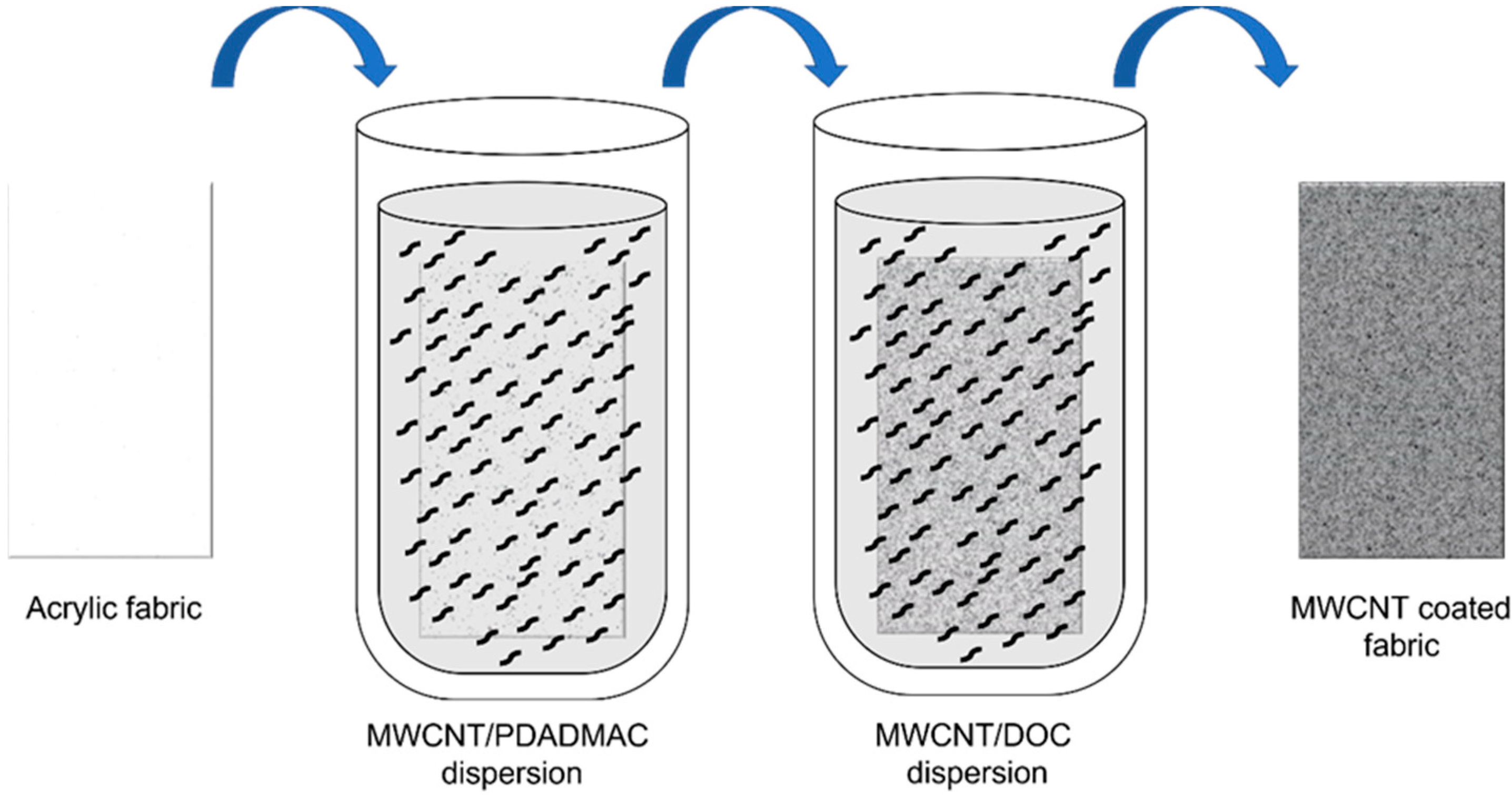
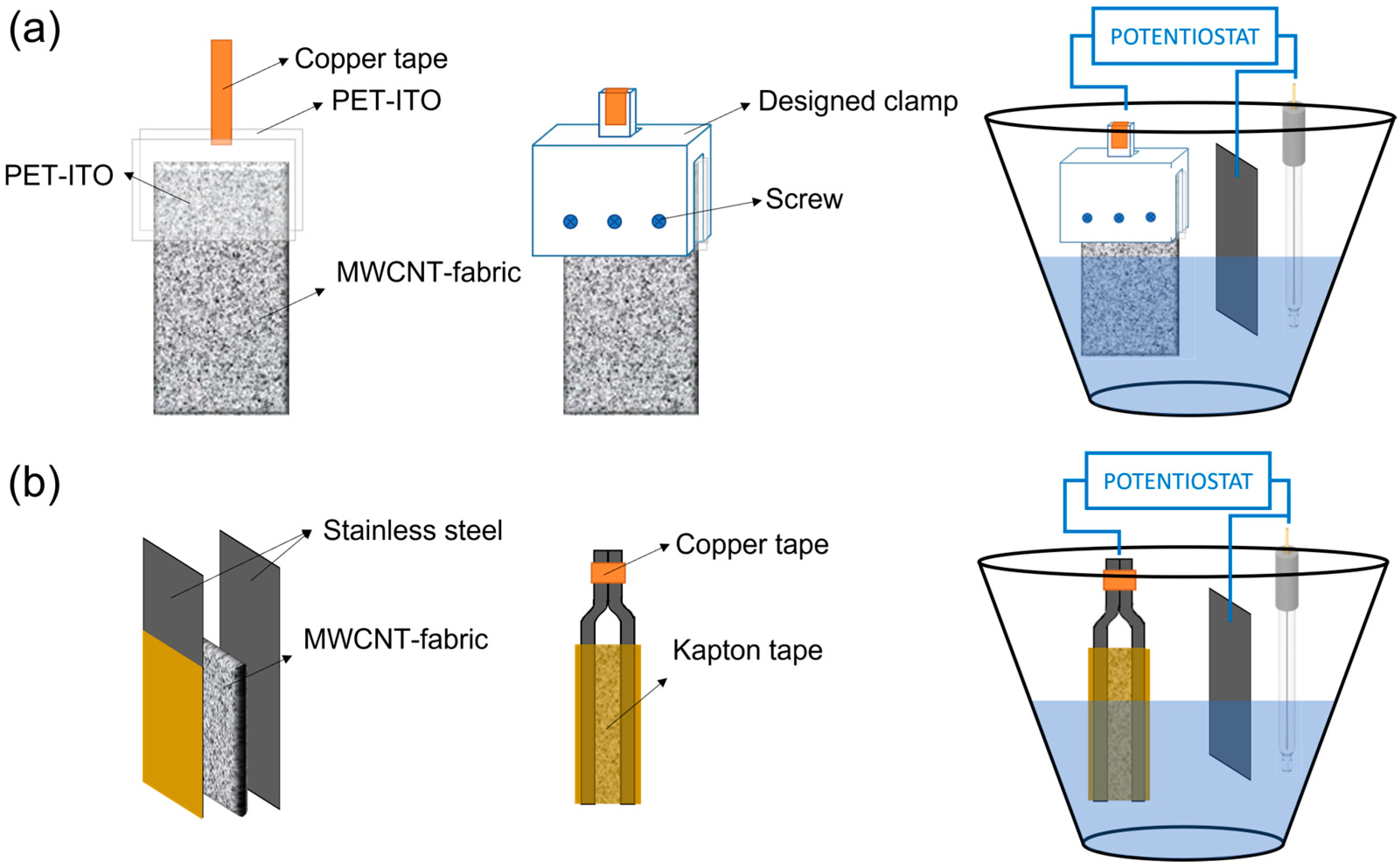
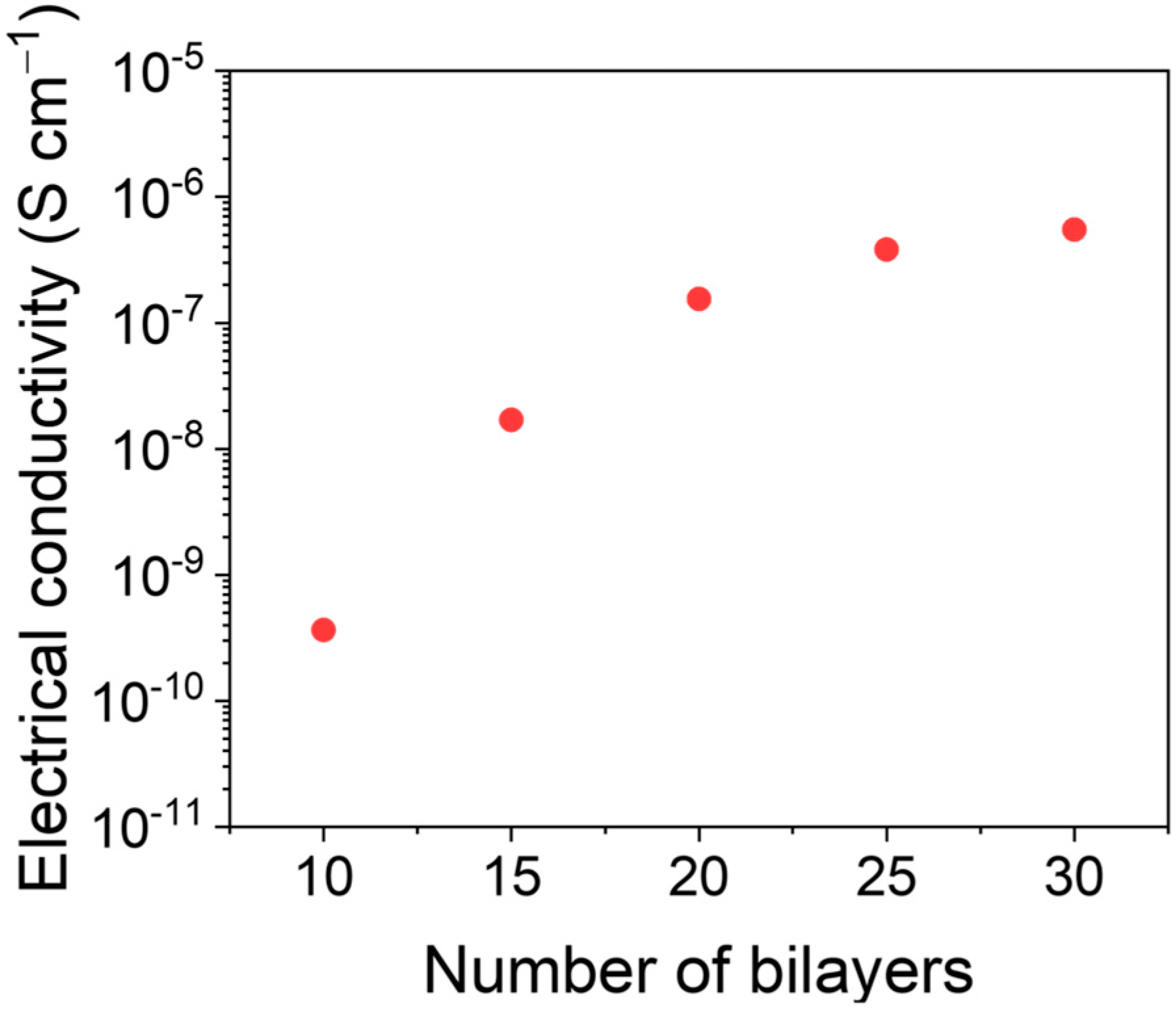
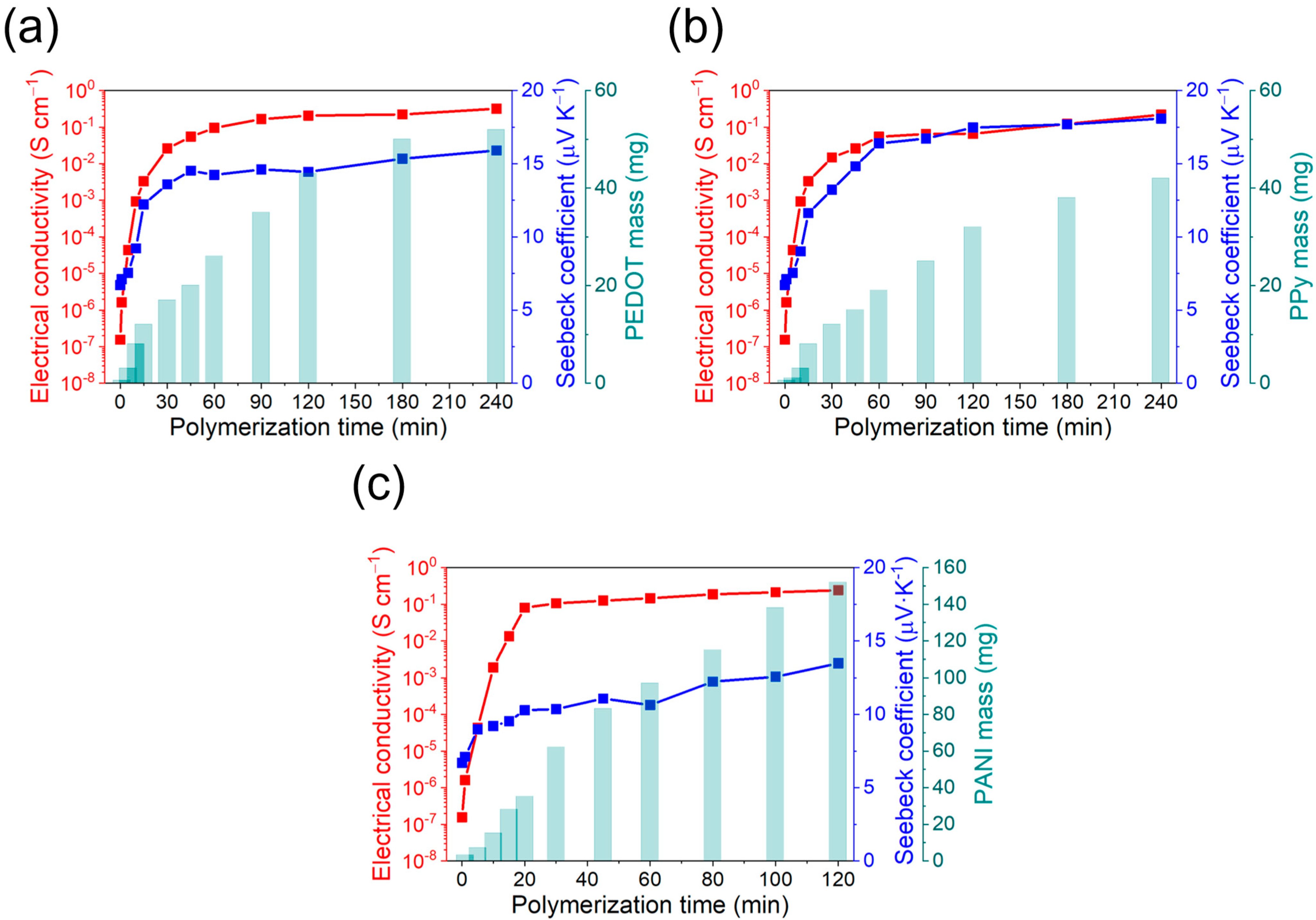

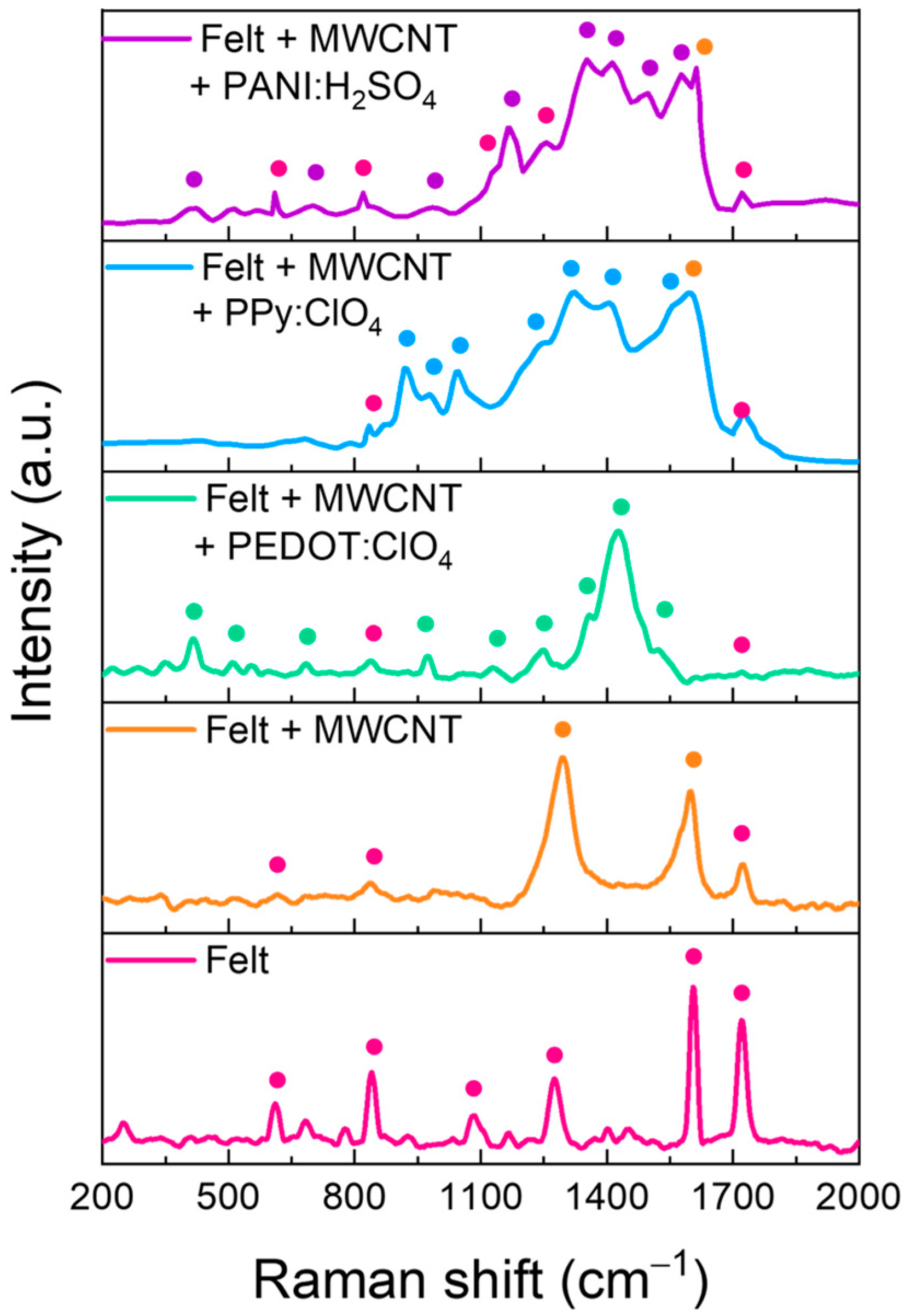
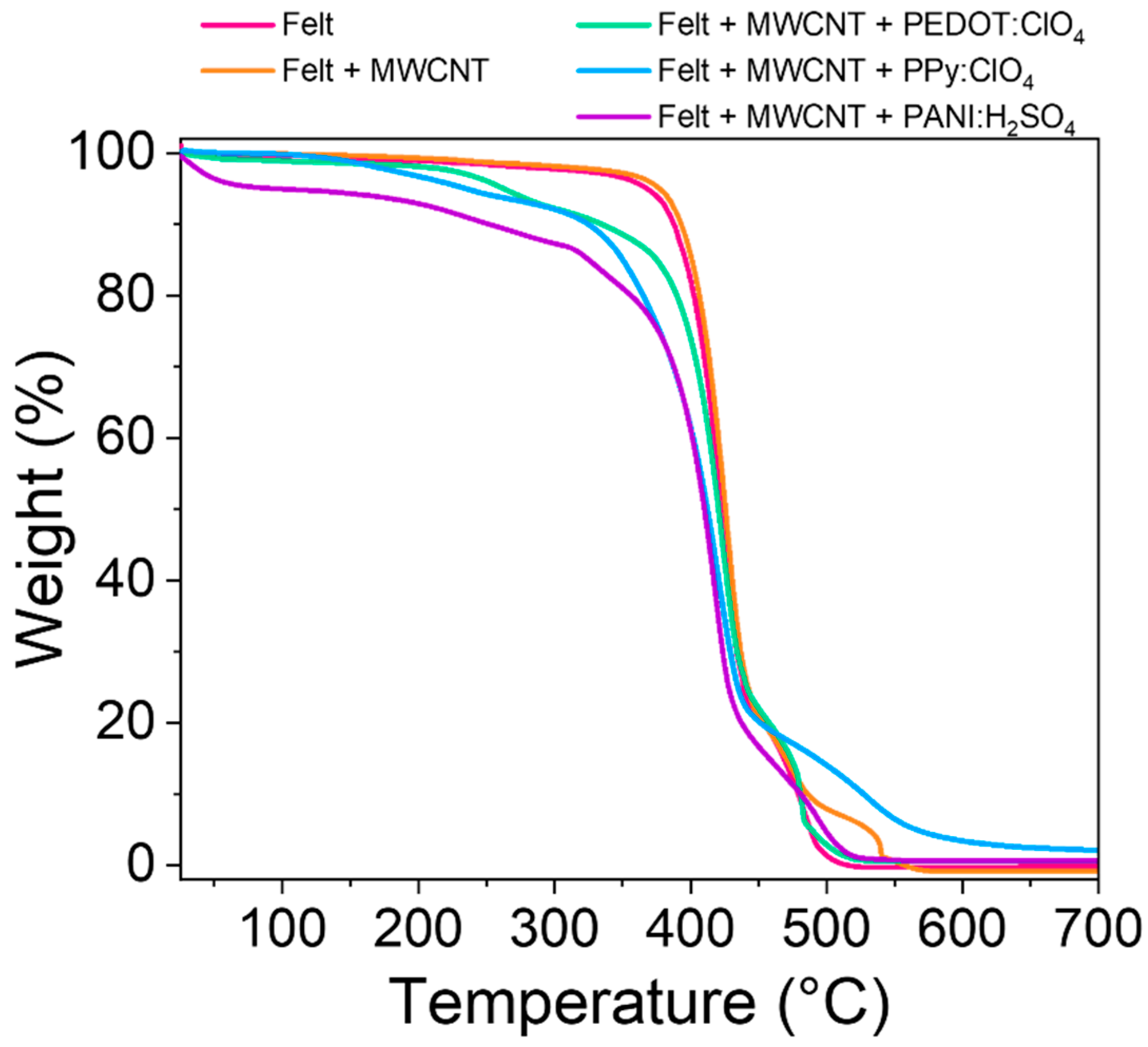
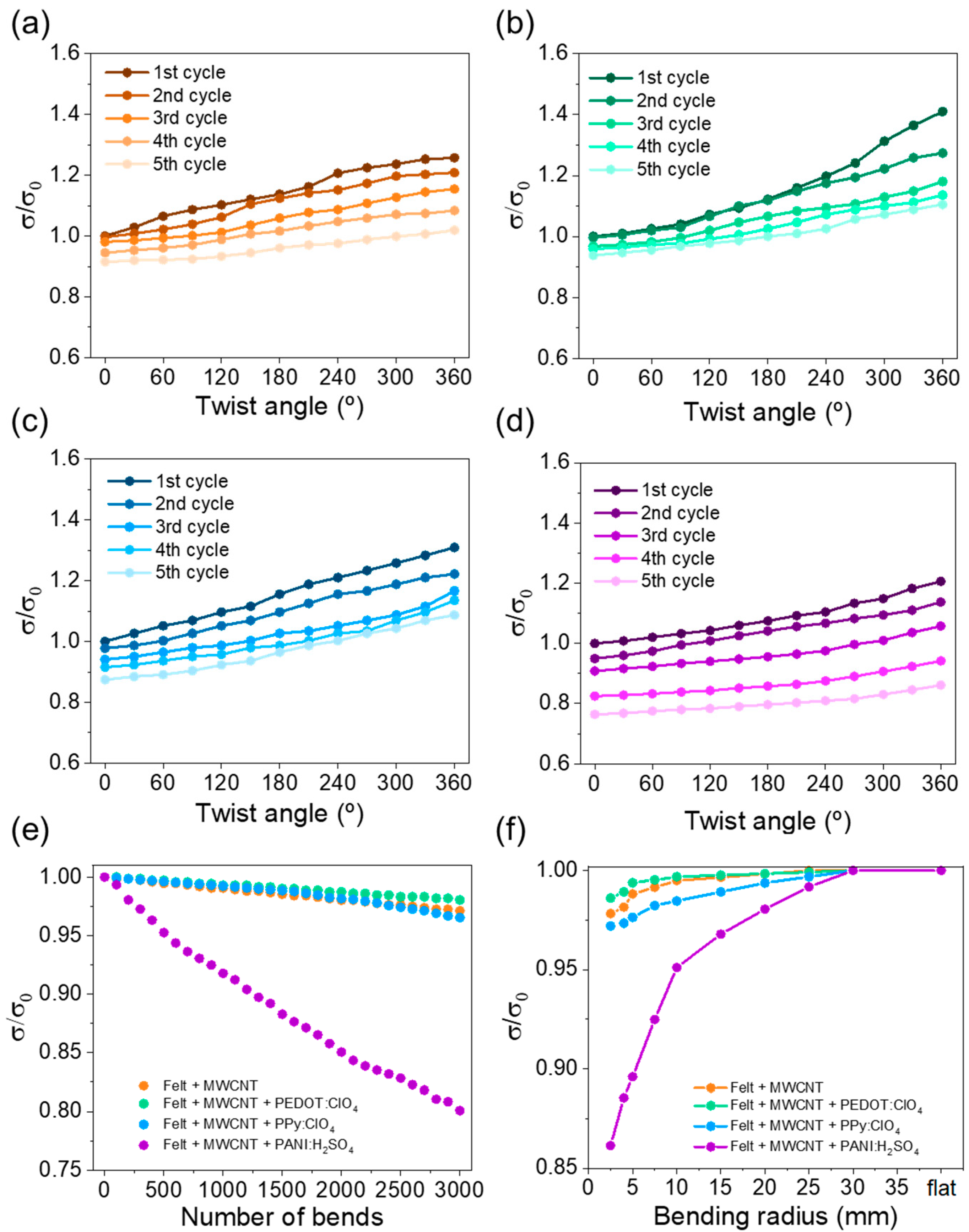
| Material | Raman Shift (cm−1) | Assignation |
|---|---|---|
| Felt | 610 | C–C aliphatic chain stretching |
| 840 | Symmetric C–O–C deformation | |
| 1082 | Asymmetric C–O–C deformation | |
| 1274 | C–C aliphatic chain stretching | |
| 1604 | Aromatic ring stretching | |
| 1720 | C=O stretching of the ester group | |
| MWCNT | 1297 | D-band |
| 1597 | G-band | |
| PEDOT:ClO4 | 420 | oxyethylene ring stretching |
| 560 | oxyethylene ring stretching | |
| 690 | symmetric C–S–C deformation | |
| 980 | oxyethylene ring stretching | |
| 1120 | symmetric C–O–C deformation | |
| 1247 | Cα–Cα (inter-ring) stretching | |
| 1356 | Cβ–Cβ stretching | |
| 1431 | Symmetric stretching of Cα= Cβ(–O) | |
| 1486 | Asymmetric stretching of C=C | |
| 1524 | Asymmetric stretching of C=C | |
| PPy:ClO4 | 918 | Ring deformation of bipolarons |
| 985 | Ring deformation of polarons | |
| 1040 | C–H in-plane deformation | |
| 1240 | C=C stretching | |
| 1323 | Ring-stretching mode | |
| 1405 | C–N stretching | |
| 1557 | Symmetric stretching of aromatic C=C ring | |
| PANI:H2SO4 | 410 | In-plane bending of benzenoid ring |
| 700 | In-plane bending of quinoid ring | |
| 984 | C–H in-plane bending of benzenoid ring | |
| 1168 | C–H bending deformation of benzenoid ring | |
| 1352 | C–N+ stretching | |
| 1412 | C–N stretching amine | |
| 1497 | C=N stretching imine | |
| 1577 | C=C stretching of quinoid structure |
| Felt | Felt + MWCNT | Felt + MWCNT + PEDOT:ClO4 | Felt + MWCNT + PPy:ClO4 | Felt + MWCNT + PANI:H2SO4 | |
|---|---|---|---|---|---|
| T5% (°C) | 367.65 | 376.85 | 262.22 | 234.39 | 91.87 |
| T10% (°C) | 387.51 | 393.02 | 334.41 | 324.54 | 251.39 |
| T20% (°C) | 402.33 | 406.45 | 389.81 | 365.05 | 355.95 |
| T30% (°C) | 411.02 | 414.41 | 404.90 | 387.32 | 387.70 |
| T40% (°C) | 417.45 | 420.40 | 413.88 | 401.99 | 401.25 |
| T50% (°C) | 422.87 | 425.65 | 420.59 | 412.31 | 410.09 |
| T60% (°C) | 427.91 | 430.68 | 426.71 | 420.69 | 417.00 |
| T70% (°C) | 433.93 | 436.84 | 434.19 | 429.13 | 423.59 |
| T80% (°C) | 452.84 | 453.28 | 457.64 | 451.20 | 437.39 |
| T90% (°C) | 479.08 | 486.04 | 480.68 | 527.04 | 480.87 |
| T95% (°C) | 487.97 | 530.56 | 488.68 | 498.77 | 482.07 |
| Residue % (700 °C) | 0 | 0 | 0.56 | 2.068 | 0.669 |
Disclaimer/Publisher’s Note: The statements, opinions and data contained in all publications are solely those of the individual author(s) and contributor(s) and not of MDPI and/or the editor(s). MDPI and/or the editor(s) disclaim responsibility for any injury to people or property resulting from any ideas, methods, instructions or products referred to in the content. |
© 2023 by the authors. Licensee MDPI, Basel, Switzerland. This article is an open access article distributed under the terms and conditions of the Creative Commons Attribution (CC BY) license (https://creativecommons.org/licenses/by/4.0/).
Share and Cite
Serrano-Claumarchirant, J.F.; Muñoz-Espí, R.; Cantarero, A.; Culebras, M.; Gómez, C.M. Electrochemical Deposition of Conductive Polymers on Fabrics. Coatings 2023, 13, 383. https://doi.org/10.3390/coatings13020383
Serrano-Claumarchirant JF, Muñoz-Espí R, Cantarero A, Culebras M, Gómez CM. Electrochemical Deposition of Conductive Polymers on Fabrics. Coatings. 2023; 13(2):383. https://doi.org/10.3390/coatings13020383
Chicago/Turabian StyleSerrano-Claumarchirant, Jose F., Rafael Muñoz-Espí, Andrés Cantarero, Mario Culebras, and Clara M. Gómez. 2023. "Electrochemical Deposition of Conductive Polymers on Fabrics" Coatings 13, no. 2: 383. https://doi.org/10.3390/coatings13020383
APA StyleSerrano-Claumarchirant, J. F., Muñoz-Espí, R., Cantarero, A., Culebras, M., & Gómez, C. M. (2023). Electrochemical Deposition of Conductive Polymers on Fabrics. Coatings, 13(2), 383. https://doi.org/10.3390/coatings13020383









